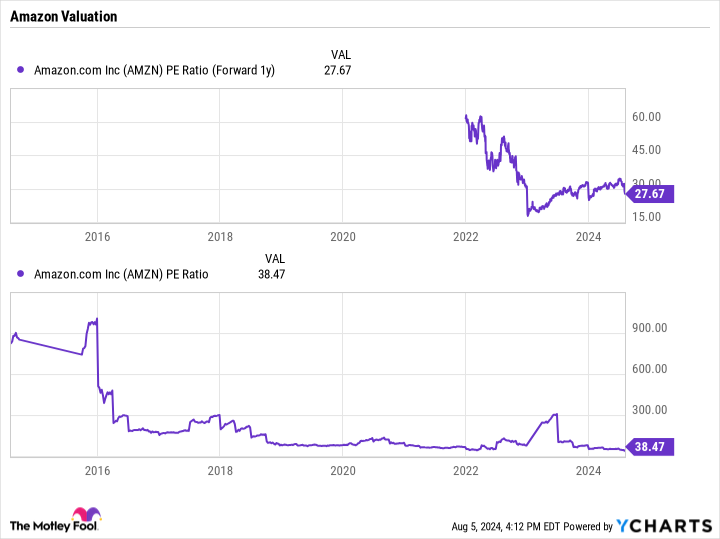August may have just begun, but it has already been a tough month for Amazon (NASDAQ: AMZN) shareholders. The stock initially sank after the e-commerce giant missed analyst revenue estimates when it reported its Q2 results.
Meanwhile, the stock has continued to drift lower, caught in the global market sell-off. A small interest rate hike in Japan and the unwinding of the carry trade appears to be one reason behind the market’s recent weakness.
Let’s take a closer look at Amazon’s most recent results to see if the sell-off is a good opportunity to buy the stock.
Second-quarter results and guidance fail to impress
When it comes to earnings, how a stock reacts is often linked to the expectations going into the results. If a company falls short of analyst estimates for a key metric or issues guidance below analyst expectations, the stock will often feel some near-term pressure.
While Amazon posted solid 10% revenue growth in its second quarter, its $148 billion in sales fell short of analyst expectations for revenue of $148.6 billion. Meanwhile, it forecast that its third-quarter sales would grow by 8% to 11% to between $154 billion and $158.5 billion. However, the $156.4 million midpoint of that range was shy of the $158.2 million analyst consensus.
The company’s cloud computing segment, AWS, led the way with revenue growth of 19% to $26.3 billion. AWS’ operating income, meanwhile, soared 72% from $5.4 billion to $9.3 billion.
North American sales climbed 10% to $90 billion, while international sales rose 7% to $31.7 billion. Advertising services led the way with 20% revenue growth to $12.8 billion. The company is upbeat about the prospects of incorporating advertising into its Prime Video service and it just inked an 11-year deal with the NBA to broadcast live games. Subscription service revenue, meanwhile, grew 11% to $10.9 billion.
Third-party seller services revenue jumped 13% to $36.2 billion. Online stores only saw 6% sales growth to $55.4 billion, while physical stores saw sales grow 4% to $5.2 billion.
Like its cloud computing competitors, Amazon plans to spend heavily to continue to build out the infrastructure needed to support increasing demand for artificial intelligence (AI) as well as non-AI workloads. As a result, its second-half capital expenditures (capex) will be higher than in the first half.
Amazon also continues to promote its new AI chips, Trainium for training and Inferentia for inference, which will have next-generation versions coming out later this year. According to management, there is a lot of demand for the chips given their price performance.
Is it time to take a dip into Amazon?
Amazon has a number of strong opportunities in front of it. First and foremost is AI, and the company is attacking this opportunity on several levels from cloud computing, to its own AI chips, to offering large language model (LLM) services.
Advertising is another big opportunity, and this area showed strong growth in the second quarter. Sponsored product ads are currently Amazon’s biggest source of ad revenue, but it will begin bringing more advertising to its Prime Video service as well. Meanwhile, its deal with the NBA will undoubtedly bring in a lot of interest and ad dollars to its streaming service.
One knock against Amazon is its valuation. The stock currently trades at a forward price-to-earnings (P/E) ratio of nearly 28 based on 2025 analyst estimates. While that is down from historical P/E levels, revenue growth at the company has slowed down over the years.
Given its revenue growth and gross margin profile, I would consider Amazon’s current valuation a bit on the high side. Amazon’s gross margins are much lower than that of a software company. For example, Microsoft has gross margins near 70%, while Amazon’s are under 50%, and around 31% when including fulfillment costs.
With the recent overall market weakness, I’d most likely take a small starter position in Amazon given the opportunities in front of it, while looking to add more if it continues to sell off and its valuation becomes more attractive.
Should you invest $1,000 in Amazon right now?
Before you buy stock in Amazon, consider this:
The Motley Fool Stock Advisor analyst team just identified what they believe are the 10 best stocks for investors to buy now… and Amazon wasn’t one of them. The 10 stocks that made the cut could produce monster returns in the coming years.
Consider when Nvidia made this list on April 15, 2005… if you invested $1,000 at the time of our recommendation, you’d have $641,864!*
Stock Advisor provides investors with an easy-to-follow blueprint for success, including guidance on building a portfolio, regular updates from analysts, and two new stock picks each month. The Stock Advisor service has more than quadrupled the return of S&P 500 since 2002*.
*Stock Advisor returns as of August 6, 2024
John Mackey, former CEO of Whole Foods Market, an Amazon subsidiary, is a member of The Motley Fool’s board of directors. Geoffrey Seiler has no position in any of the stocks mentioned. The Motley Fool has positions in and recommends Amazon and Microsoft. The Motley Fool recommends the following options: long January 2026 $395 calls on Microsoft and short January 2026 $405 calls on Microsoft. The Motley Fool has a disclosure policy.
Should Investors Buy the Dip in Amazon Stock After Shares Slide on Revenue Miss? was originally published by The Motley Fool

Jessica Roberts is a seasoned business writer who deciphers the intricacies of the corporate world. With a focus on finance and entrepreneurship, she provides readers with valuable insights into market trends, startup innovations, and economic developments.








